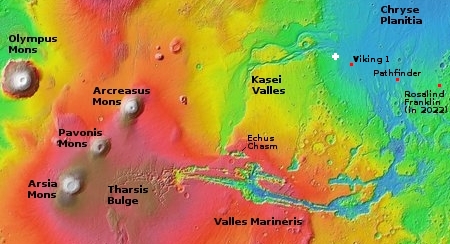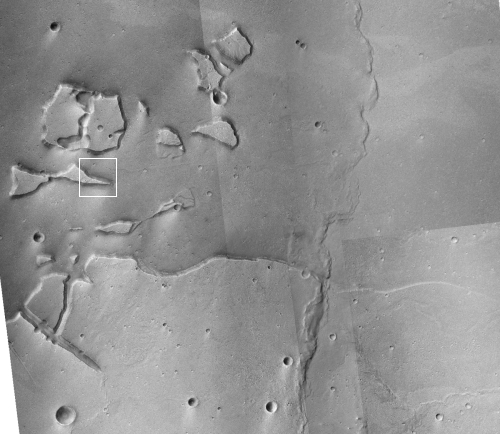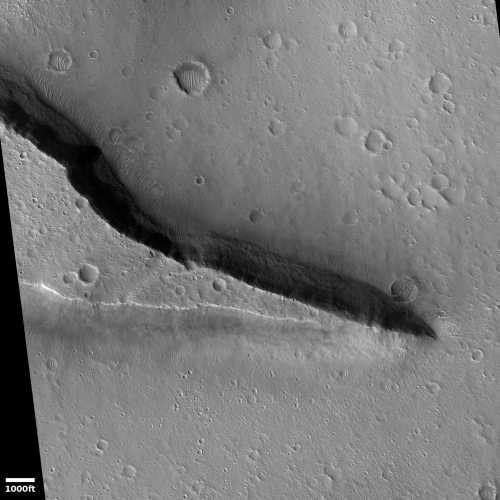A great hike to do on Mars!
Time to take a cool image and go sight-seeing. The photo to the right, cropped and reduced to post here, was taken by the high resolution camera on Mars Reconnaissance Orbiter (MRO) on May 25, 2020, and shows a spectacular knife-edge mesa, its cliffs more than 650 feet high on either side.
This knife mesa sits among a bunch of similar mesas, and appears to be in a region that could be called chaos terrain, formed by flowing water or ice along faults, cutting criss-crossing canyons with mesas between.
This mesa points east out from the Kasei Valley, the second largest canyon draining out from the Tharsis Bulge that contains Mars’ largest volcanoes. The overview map below provides some context, with the white cross indicating the location of today’s cool image.

According to this 2019 paper [pdf], Kasei Valles was created by both volcanic and glacial processes, with the added possibility of liquid catastrophic floods. This particular paper theorized that the upper section of Kasei, oriented south-to-north and relatively smooth-floored and oblong-shaped, was once a large lake caused by a dam that when that dam broke the water quickly flooded the lower parts of the valley, causing the deeper channels and mesas we see there.

What I saw when I first looked at this image was a magnificent place to hike. Imagine walking along the crest of this mesa, with outstanding views in all directions!
The mosaic to the right was compiled from four photos taken by the context camera on MRO, designed to give scientists a wider view. The white rectangle indicates the location of the above image. From this overview the chaos terrain nature where this mesa exists is obvious. Also visible is evidence of a catastrophic flow pushing through from the west to the east, carving these mesas as well as many smaller features in the bottom-lands as that flow drained out into Chryse Planitia, part of Mars’ vast northern lowland plains.
What makes this knife mesa even more enticing as a future hiking objective is that, not far beyond the eastern edge of this mosaic sits Viking-1, the first spacecraft to successfuly soft land on the Martian surface, placed there by the United States on July 20, 1976, the seventh anniversary of the Apollo 11 landing on the Moon.

To the right is the same image from above, but this time I have annotated it with a proposed hiking trail, working along the south rim of the mesa to then switchback down the mesa’s nose, where the slope is reasonable. The trail could then head out onto Chyse Planitia towards that Viking-1 landing site, about 100 miles away.
In fact, I could easily see later generations of Martian settlers creating a Mars-wide trail, running from Olympus Mons, to the southeast between Arcreasus and Pavonis Mons, then to the northern rim of Marineris Valles, then cutting north into Kasei Valles to follow this valley to traverse Knife Mesa for its views, then out into Chryse Planitia to visit the landing sites of Viking 1, Pathfinder, and the European rover Rosalind Franklin.
And that’s only this side of the planet. The trail could circle the globe, visiting many of the first unmanned landing sites as well as some the Mars’ most spectacular geological features.
I know this proposed trail is only a casual fantasy of mine. I also know that it will someday be real, if only we remain bold and continue to attempt great things, despite the risk.
On Christmas Eve 1968 three Americans became the first humans to visit another world. What they did to celebrate was unexpected and profound, and will be remembered throughout all human history. Genesis: the Story of Apollo 8, Robert Zimmerman's classic history of humanity's first journey to another world, tells that story, and it is now available as both an ebook and an audiobook, both with a foreword by Valerie Anders and a new introduction by Robert Zimmerman.
The print edition can be purchased at Amazon or from any other book seller. If you want an autographed copy the price is $60 for the hardback and $45 for the paperback, plus $8 shipping for each. Go here for purchasing details. The ebook is available everywhere for $5.99 (before discount) at amazon, or direct from my ebook publisher, ebookit. If you buy it from ebookit you don't support the big tech companies and the author gets a bigger cut much sooner.
The audiobook is also available at all these vendors, and is also free with a 30-day trial membership to Audible.
"Not simply about one mission, [Genesis] is also the history of America's quest for the moon... Zimmerman has done a masterful job of tying disparate events together into a solid account of one of America's greatest human triumphs."--San Antonio Express-News



It sounds as though your proposed trail could exceed the length of the Appalachian Trail. That isn’t going to be something easily traversed on foot even in 3/8-G with a suitable spacesuit.
There’s also the little matter of where all the air/breathing mix would come from to keep even a single notional hiker alive as he ambles along. Unless there are shelters with stationary air plants that run on solar or beamed power and make breathable air out of the martian atmosphere situated at fairly short intervals all along the “trail,” a “hiker” would have to carry his breathing mix with him. If Earthside hiking trails needed a comparable level of infrastructure to keep hikers alive, no one would hike.
Carrying breathable “air” in sufficient quantity to cover any appreciable distance might not be possible even using, say, a mastodon-sized version of a Boston Dynamics robot “dog” or “mule.” The necessity of having something that size following one on the “trail” would necessitate said trail being a rather considerable road. Imagine, if you will, widening the Appalachian Trail to allow each hiker to be followed by a Caterpillar D-10 bulldozer – not the sort of experience an Earthside hiker would be looking for.
Dick Eagleson: I guess you’re right. It can’t be done. No point in even trying.
Robert… great idea, i like it! The younger generation of which my kids are a part have dreams to getting to Mars. And such exploration will be part of it all. Good article, thanks.
We consume a little less than a kg of O2 a day. No reason a liquid oxygen system couldn’t sustain a person for a week or more, water supply comes with the LOX and possibly Cryogenic CO2 scrubbing.
Robert Zimmerman replied to Dick Eagleson: “I guess you’re right. It can’t be done. No point in even trying.”
Sarcasm aside, these are exactly the types of problems that we expect Martian citizens to explore and solve.
With all due respect to Mr. Z., I think early Mars settlers are going to have a lot of appreciably higher priorities than figuring out ways to make hiking work there. On the scale of difficulty of transplantation of Earthside leisure activities to Mars, anything requiring a large body of water will top the list – sailing, motorboating, water skiing, scuba diving, fishing, surfing, cliff diving – you get the idea. Hiking is, in comparison, much easier but still not easy. Mountain biking would be a lot easier to transplant to Mars than hiking. Motorcycle trail riding would be easier than mountain biking.
The Appalachian Trail didn’t become a thing until more than three centuries after the arrival of the first British colonists in Virginia and Massachusetts. I suspect it won’t take anywhere near that long for a comparable trail to be established on Mars, but I’m also sure I won’t live to see it and I suspect my offspring won’t either.
Dick Eagleson, stop telling future Mars colonists how to live their lives.
Robert – back to your ‘casual fantasy’, surmise for a moment that if the Martian atmosphere was much more amenable to us, say just needing supplemental oxygen and a light mask, do you think the space race would have continued and we would have already had a manned landing in the 70s or 80s, or do you think the technical difficulties, government overrun/lethargy, and lack of private interest until now would have held us back to this time frame (2030s) anyway?
MatF: You ask a “what-if” question, which are by definition really unanswerable. Personally I do not think a more friendly Martian environment would have made any difference in what happened after the 1960s space race. The U.S. was primed to try out the Soviet model of top-down rule in its space effort, and would have done so regardless. The result would have been the same, decades of wasted government spending accomplishing little.
I have a t-shirt (wish I could post pictures) in the style of national park posters which says: “Hike the canyons of Mars National Park” with an appropriate illustration.
Robert Zimmerman suggested: “I do not think a more friendly Martian environment would have made any difference in what happened after the 1960s space race.”
I suspect that had the Martian environment been more like the Louisiana Purchase then we would have been more eager to get there. As it is, many people ask why we even think of going there, since nothing is there, not even breathable air.
Fortunately, there are civilians willing to spend private money (their own money) to go where governments are reluctant to go, even though they spend public money (other people’s money).
Andrew _W,
I’d hardly say I’m “telling future Mars colonists how to live their lives” by simply pointing out that the transplantation to Mars of Earthside leisure activities will cover a range of difficulty from easy to impossible. Mars colonization will be, especially in the early going, strictly the province of people with hard heads and pragmatic mentalities. Self-selection will see to it that no one who can’t live without their sailcraft or aqualungs is going to be a Mars colonist. Hiking as a leisure activity may eventually come to Mars, but not soon.
Dick Eagleson, I would think that hiking is a natural off-shoot of exploration, that people choosing to go to Mars would have a strong inclination towards that sort of thing.
Sorry Mr. Zimmerman, I wasn’t paying attention when putting the name in the box in above comment.
Fixed.